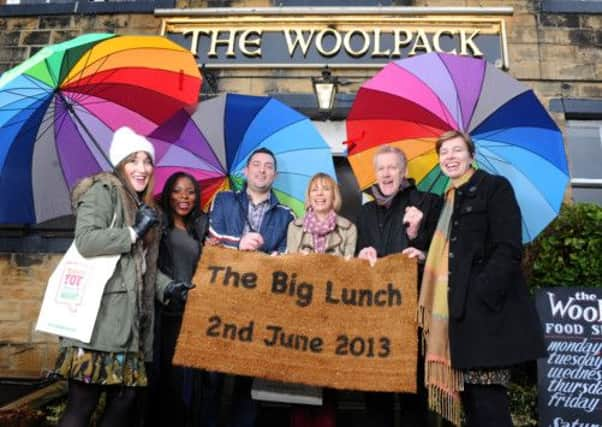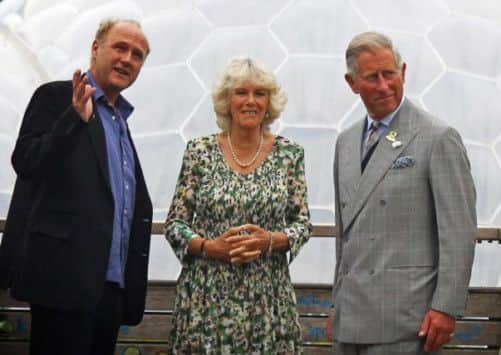Lunch and architecture set to restore our long-lost sense of neighbourliness


In those halcyon days when corner shops proliferated, streets were largely car-free and children played out, there were endless opportunities to meet and chat with the neighbours.
Now a quarter of us don’t even know the names of the folk next door and many of us are barely on nodding terms with them.
Advertisement
Hide AdAdvertisement
Hide AdThis social isolation has had a direct impact on our health and well-being, according to researchers, who say that older people are most affected.


While experts ponder how to tackle the issue, green entrepreneur Sir Tim Smit, co-founder of the Eden Project, is busy promoting his own solution.
Like most good ideas, it is simple. The Big Lunch, an annual event that began in 2009, encourages neighbours to organise street parties so they can get to know each other over a Jacob’s join.
The Lottery-funded initiative simply encourages neighbours to share a few hours of food, friendship and fun. This year it will take place on Sunday, June 2.
Advertisement
Hide AdAdvertisement
Hide AdOf course, it was a concept that reached its zenith last year as thousands of Britain’s braved the weather to stage their own street parties to mark the Queen’s diamond jubilee. The Big Lunch initiative joined forces with this special red letter day and, as a result, some 8.5m took part.
That was exceptional - but it’s just that spirit which The Big Lunch aims to maintain.
“We are, by nature, a very reserved nation,” says Sir Tim. “This is a chance for people to knock on each others’ doors and come together over lunch. They get to know each other and it goes from there. It’s simple but effective.”
One of the best examples of the Big Lunch’s success is in Chapel Allerton in north Leeds.
Advertisement
Hide AdAdvertisement
Hide AdAfter seeing a TV advert about the event, Matt Tamplin decided to knock on doors in his street to see is there was any interest.
“I used to be an events manager but I was temping at the time, which wasn’t particularly challenging.
“When I saw the ad I thought: ‘I can do that’ but I got a mixed reaction from people. A few weren’t interested and looked at me as if to say: ‘who are you and why are you knocking on my door, asking me to lunch?’ But the overwhelming response was that lots of people were up for it.”
What started as a “bit of a do” that attracted 75 people has grown into CARA, Chapel Allerton Residents Association, which covers the whole suburb.
Advertisement
Hide AdAdvertisement
Hide AdIt organises social events, classes in everything from wine tasting to jewellery making, raises money for charity and has discount schemes that encourages people to support local shops and businesses.
Its Facebook group has over 2,000 members and there’s even a website: www.lovechapelallerton.com. Friendships have been forged, romance has blossomed and community spirit abounds in Chapel A.
“So many people have made friends and one couple who met at the first lunch are still together,” says Matt, who is helping to plan the latest Big Lunch due to be held in a few weeks time.
“Someone lost their dog recently and posted a message on the Facebook page and within a couple days he had the dog back. That couldn’t have happened a few years ago.”
Advertisement
Hide AdAdvertisement
Hide AdSir Tim Smit has a few other ideas on how to get people together.
“We need more Post Offices. Many of them were forced to close which was terrible, because I’d like to see Post Offices that are multi-functional and that offer access to the internet, a café, a GP surgery and a corner shop.
“I also think we need more outdoor play facilities for children and young people and we need to utilise churches for community events.”
Architect Ric Blenkharn believes that good design can promote neighbourliness.
Advertisement
Hide AdAdvertisement
Hide AdRic, co-founder of Malton-based Bramhall Blenkharn, says: “Design can make such a difference to how we live.
“It’s not only buildings themselves, but the spaces between them that can generate a sense of well being and community.
“Traditionally, market places and public squares were important social hubs for people to meet and pass the time of day.
“Thoughtful design can create such places, where contact is not forced but is natural and comes through chance meeting.
Advertisement
Hide AdAdvertisement
Hide Ad“There is also a tendency today to create gated communities or for people to hide behind security gates and high walls, but if homes are orientated with entrances that face each other, they encourage contact between neighbours and can actually reduce crime.”
Architect Alex Ely, a member of the RIBA Housing Policy Group, would like to see people friendly streets with good landscaping, chicanes, trees and seating areas to slow traffic.
“When we walk out of our homes most of us want to be able to mix with our neighbours or look across a pleasant street.” he says. “Too often, the design of housing has been determined by the demands of the road system, to the neglect of the creation of a sense of place.
“If you happen to bump into someone while walking down the street, it will usually result in an apology or perhaps a polite conversation.
Advertisement
Hide AdAdvertisement
Hide Ad“A similar incident between two cars, however, is more likely to lead to anxiety, rage or hospitalisation.”
Building right first time is what LILAC, the Low Impact Living Affordable Community, did when they created 12 flats and eight houses in Bramley, Leeds. The properties were designed to create social interaction.
The 42 men, women and children, who recently moved into their new, strawbale-built co-housing scheme, have created a shared common house with a kitchen, dining room, office, workshop and activity area where residents can share everything from meals to tools and toys.
The two rows of houses face each other and kitchen sinks are strategically placed under the windows so you can give a cheery wave to passers-by while doing the dishes.
Advertisement
Hide AdAdvertisement
Hide AdThere are no washing machines or tumble dryers in the homes, so residents have to use the on-site laundry, giving them a chance to meet and chat with their neighbours.
They can also swap gardening tips as every home has it its own allotment.
Inspired by co-housing projects in Denmark, LILAC was launched five years ago by a group of friends, who were looking for affordable homes.
Unlike the communes of the 1960s and 70s, those living in co-housing schemes have a home of their own and share facilities.
Advertisement
Hide AdAdvertisement
Hide AdAlthough they have their own kitchens, cooking and eating communally is encouraged. The emphasis is on creating a caring, eco-friendly and sociable community.
The Homes and Communities Agency, which part-funded a grant to help LILAC clear the former school site ready for development, said it was a “model for the future”.
LILAC member Alan Thornton says: “We thought there must be a better way of living, where you still have your own separate dwelling, but you know all your neighbours and you share resources.
“We have designed in conviviality.
“You’re more likely to walk past each other on this site and there are lots of opportunities for communicating with each other whether it’s at the laundry or in the central post room in the common house.”
Advertisement
Hide AdAdvertisement
Hide AdMeanwhile, if you are stuck with architecture that doesn’t encourage neighbourliness, then think about organising a Big Lunch.
As Matt Tamplin says: “If you knock on a few doors and ask you’ll be surprised how many people will say ‘yes’.”
For further information or to request your free pack including posters, invitations, a planner and other materials to help organise your Big Lunch, simply visit: www.thebiglunch.com or call: 0845 8508181.
The big lunch’s big cheese
Sir Tim Smit was born in Holland in 1954. He read Archaeology and Anthropology at Durham University then worked in the music industry as composer/producer in both rock music and opera. In 1987 Tim moved to Cornwall, where he and John Nelson together ‘discovered’ a forgotten Edwardian estate and restored the Lost Gardens of Heligan.
Advertisement
Hide AdAdvertisement
Hide AdTim then co-founded the Eden Project near St Austell in Cornwall. Eden began as a dream in 1995 and opened its doors to the public in 2000, since when over 13 million people have come to see what was once a sterile pit turned a horticultural and architectural wonderland. It includes two vast greenhouses reproducing the rainforest and other ecosystems.